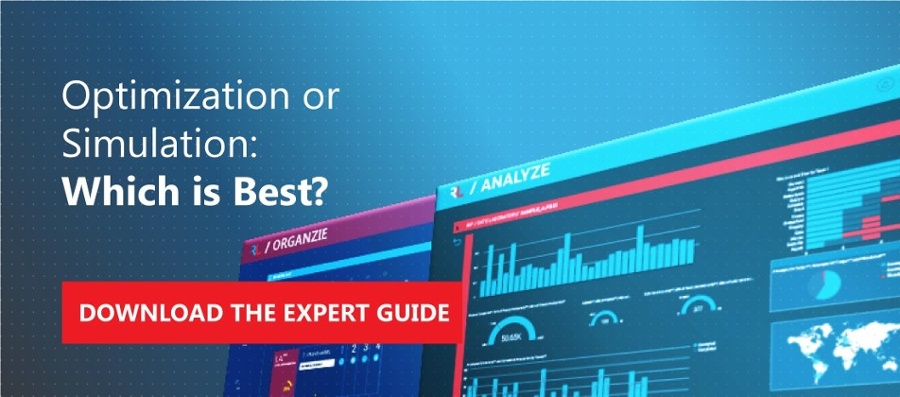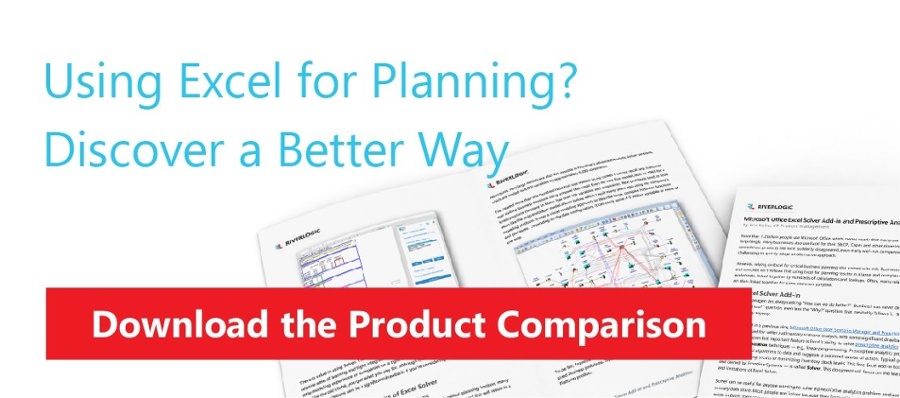The success of supply chain simulation depends on many factors, including:
- Development of a realistic model
- Access to structured and unstructured data
- Advanced predictive technologies
- Solver software with the ability to determine the optimal solutions to different scenarios
It’s this last point which is perhaps the most important aspect. Usually known as prescriptive analytics, this form of analytics forms the basis for successful supply chain simulation software, giving supply chain professionals the ability to evaluate different supply chain scenarios and determine the optimal solutions to supply chain issues.
What Is Supply Chain Simulation?
Gartner defines simulation as “the use of a mathematical or computer representation of a physical system for the purpose of studying constraint effects.”
Gartner goes on to state that increasingly complex supply chains require sophisticated modeling techniques combined with simulation and optimization techniques in order to obtain a more realistic representation of the supply chain to determine how to meet business goals.
In this context, supply chain simulation can be defined as a mathematical process used to accurately model a supply chain and the use of mathematical optimization techniques to determine the best answers to questions relating to the structure, operation and integrity of the supply chain.
Events of 2020 Illustrate the Need for Better Supply Chain Scenario Planning
As the world has belatedly discovered during the COVID-19 epidemic, supply chain simulation software is only as good as the information fed into it, as well as the ability of its algorithms to remove human bias. For example, while the risk of a global pandemic was known, hardly anyone predicted the extent this would disrupt global supply chains.
While the degree of disruption was unprecedented, there’s no question that had planners not been so focused on supply chain efficiency and lowest cost, they might have properly evaluated global supply chain risk to account for such disruptions. There were plenty of warning signs, including recent epidemics and disruption caused by natural disasters. So, it’s not as if the risk wasn’t palpable, but it’s clear it was ignored in global supply chain simulation studies.
Benefits of Supply Chain Simulation
If you can accurately simulate your real-world supply chain, then it will be possible to try out different supply chain simulation strategies on your virtual supply chain before implementing them in the real world. This technique is sometimes called a digital twin, as it mimics the operation of the real supply chain, allowing you to evaluate the effect of different inputs and what-if scenarios.
Benefits of a supply chain simulation strategy include:
- An ability to review how different components of the supply chain interact
- Measuring the impact of proposed changes
- Testing out major upgrades before implementing them in the real world
- Evaluating different scenarios
- Posing what-if questions
Additionally, the most important benefit of supply chain simulation is the ability for optimization-based scenario planning. In other words, to determine specifically how to optimize key metrics such as supply chain:
- Cost
- Risk
- Efficiency
- Inventory
Supply Chain Simulation Software
If you, like most supply chain professionals, use materials resource planning (MRP) software, or one of its successors, you will know this powerful software excels in organizing and scheduling raw materials and production. But you probably also know that few if any forms of MRP software offer any real ability to optimize planning other than to schedule efficiently. Attempting to use such software for decision-support purposes that focus on broader optimization to higher-level KPIs would prove unsuccessful.
Some forms of MRP allow users to run simulations with different planning parameters, allowing users to predict those which give a satisfactory result. What’s missing, though, is an ability to take external factors into consideration and to truly optimize the result (across as many constraints, market variables, and objectives as one would want). The reason for this is that MRP, for good reason, is a logic-based system based on a series of predetermined rules.
In almost all instances, it can’t take into account external factors such as choice of supplier, supply routes, supply constraints, trade-offs and other factors.
A better approach is the use of simulation techniques based on mathematical optimization such as Monte Carlo optimization and mixed integer optimization. These techniques, together with the use of sophisticated mathematical modeling, allow users to construct detailed supply chain models that simulate how the supply chain actually functions. Additionally, prescriptive analytics simulation offer the added ability to analyze trade-offs, manage short- and long-term constraints, and answer what-if questions to optimize the supply chain network.
When to Use Supply Chain Simulation
A supply chain simulation strategy can have many elements, including analyzing the product mix, evaluation of different scenarios and answering what-if questions relating to strategy. Here are three examples of when to use supply chain simulation.
Product mix analysis
One of the most challenging decisions facing supply chain organizations is deciding on a right product mix. While some products may offer high profits, others have greater turnover. Some products may dovetail with the organization’s long-term strategy, while others don’t but are profitable. In most instances, these decisions are extremely complex, and it’s difficult to evaluate how they will affect overall revenue to profitability. A simulation can provide the right answers.
Scenario analysis
Typically, supply chain managers face multiple options when sourcing products. They need to look at questions such as supplier location, price, delivery cost, shipping and tariffs as well as risk, continuity of supply and quality. Using simulation, a prescriptive analytics–based scenario analysis allows them to evaluate these and other factors to determine which of many alternatives offers the lowest risk, generates the highest financial contribution and best supports the business.
S&OP what-if analysis
What happens if the global economy collapses? A few months ago, no one would have predicted this could be even a remote possibility, and yet it happened. S&OP what-if analysis allows supply chain leaders to simulate what would happen if xyz occurs. It highlights risk, not only to the bottom line, but also in terms of the ability to supply. While this approach does depend upon asking the right questions, simulation modeling offers data-driven answers to S&OP what-if questions.
Alternatives to Supply Chain Simulation
Is there an alternative? Not really, unless you want to continue to base your decisions on hunches and gut feel. Except in the simplest situations, there’s simply too much complexity for anyone to figure out the right alternatives without supply chain simulation support.
Simulation requires two elements: a viable model and some form of mathematical optimization software allowing you to evaluate different alternatives. One possibility is Excel’s scenario manager, which works well in relatively simple scenarios but falls short when evaluating large and complex scenarios. Another option is using a third- or fourth-generation programming language to hardcode a simulation model and solver software to determine an optimal solution.
The most recent method is visual code-free constraint-based modeling that obviates the need for high-level programming capabilities, greatly simplifying the simulation process and bringing these capabilities within the reach of supply chain managers.
Don’t Be Caught Out Again
Supply chain simulation is not a luxury. Rather, it’s a practical process that’s essential for success in these stressful times. Many fine companies are in dire straits because their supply chains could not adapt to new realities. There’s never been a greater need for supply chain simulation software able to take the bigger picture into account. As Supply Chain Shaman Lora Cerere says in a recent blog, businesses that continue to tinker around without making fundamental changes are a bit like deckhands rearranging the deckchairs on the Titanic while ignoring the real risk of striking an iceberg.
As you face these supply chain challenges, you need the certainty offered by a supply chain simulation strategy supported through prescriptive analytics.








